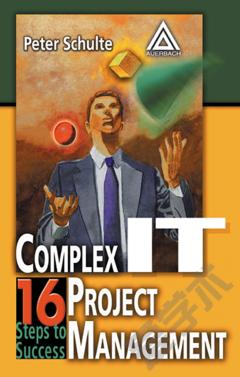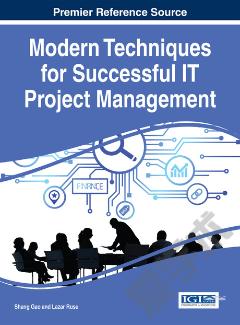Complex IT Project Management —— 16 Steps to Success
----- 复杂IT项目管理:成功16步
PROJECT IS MORE THAN ITS TECHNICAL DELIVERABLES Provisioning ISDN How Did We Do? The Project in Context The Big Thirteen Discovery Techniques Interviewing Techniques LEARNING REQUIREMENTS IS OUR FIRST PRIORITY The Trouble with Requirements ISDN Case Study Requirements How Requirements Are Derived An Airport Is Born Applying the Big Thirteen Develop an Issues List Eliminate as Many Issues as Possible Assign Real Issues to the Right Party Why You Assign Issues Turning Issues into Assumptions Socialize Your Assumptions Analyze and Incorporate Feedback Get Universal Signoff on Requirements Address the Feasibility of Implementing Requirements Turning Requirements into Specifications Mapping Requirements to the Project Plan Work Flow Analysis USING TECHNOLOGIES TO MEET REQUIREMENTS Why Technologies Should Be Used How Technologies Really Get Used How Technologies Fail How to Determine if It Is Going to Work Understand Your Technologies Review Validation Plan Review Risk Review Potential Integration Issues Review with Customer and Beneficiaries Submit to Technology Review Board if Required Commence Validation Processes, and Adjust as Required Proceed with Rollout, Invoking Your Plan Bs as Required DEVISING AN IMPLEMENTATION STRATEGY PRECEDES SCHEDULING What Is an Implementation Strategy? That Was an Implementation Strategy Why Do I Need an Implementation Strategy? How Do I Use This Implementation Strategy? Building Your Implementation Strategy Finding Gaps with the Implementation Strategy Implementation Strategy Components An IT Implementation Strategy Example A Vendor Management Implementation Strategy PLAN B IS AN INTEGRAL PART OF THE PROJECT PLAN What Is a Plan B? A Word About Risk When Is Risk Risk? Identifying Risk Murphy's Law Uncovering Project Risk Uncovering Beneficiary Risk Uncovering Corporate Risk What to Do with These Questions The Cost of Risk Management Next Steps in Risk Planning Plan B Strategies Plan B Triggers Sample Trigger Pulling Your Plan B Together Sample Plan B: A Not So Wide Area Network Writing The Plan Planning Process Objectives Six Steps towards Successful Planning Starting the Schedule Build The Project Pyramid How to Use the Pyramid Getting Serious about Your Schedule Drafting the First Master Schedule Selling the Critical Path Getting Ready for the Detail Finally, Your Project Calendar Managing Team Lead Plan Detail Pulling It All Together HOW TO STATUS YOUR PROJECT Rules of Engagement The Politics of Bad News and Escalation The Shell Answer Man Raising a Project "Jeopardy" Checking Status against the Project Plan Status Report: Smooth Sailing Status Report: Rough Waters Ahead Handling Challenges to the Schedule Generic Reactions Adjusting Your Schedule Issues List When Late Matters Quality of Deliverables MANAGING PROJECT INFORMATION Documentation Guidelines What You Should Document Communications Strategy Meetings MANAGE YOUR DOLLARS Where Did the Number Come From? Budgetary Assumptions Budgetary Source Data Creating Estimates Budget Laundry List Things Can Look Odd under the Budgetary Microscope Handling Prospective Shortfalls Service Delivery and Cost Recovery When Is an Approved Expenditure Approved? Where Does the Money Go? Tracking Expenditures Overruns UNDERSTANDING AND MANAGING VENDORS About Vendors Existing Vendors New Vendors Vendor Selection Process Doing RFPs Right Thirteen Steps of Vendor Management MANAGE YOUR TURNOVER The Handoffs Production Support Models Understanding the Model Support Requirements Runbooks Negotiating Support HANDLING YOUR TEAM Working with People as a Manager Leadership Your Role versus Theirs Decision Making Infighting Coaching and Mentoring Ownership Follow the Bouncing Ball Project Team Table Manners MANAGING CUSTOMERS AND BENEFICIARIES How It Is Supposed to Work The Customer May Not Always be Right ... Lead, Follow, or Get Out of the Way Speeds and Feeds The Dynamics of Public Presentations Managing Objections You Can Run but You Cannot Hide Evaluating Beneficiary Risk Recognizing Scope Creep Reacting to Scope Creep Joint Planning with Beneficiaries Roles and Responsibilities User Acceptance Testing Service Levels Through the Looking Glass from the Other Side Bearing Bad News Negotiations HANDLE YOUR MANAGEMENT How Much Autonomy do Project Managers Have? Management Traits to be on the Lookout For Management Style Problem Solving Your Manager's Political Tendencies Procrastination Conflict Avoidance Risk Aversion Grasp of Theory and Details Communications Skills Basic Rules of Boss Management LESSONS LEARNED How Do People Learn? Setting the Goals for Your Lessons Learned How Well Was Scope Implemented? Positive Contributing Factors Negative Contributing Factors Gathering the Team Together Samples Example: SouthPointe Lessons Learned BECOMING THE PROJECT ADULT A Day in the Life Becoming the Project Adult What Makes a Great Project Manager? Experience and Training Professional Skills Personal Attributes About Consulting Project Managers And Finally...
{{comment.content}}








 京公网安备 11010802027623号
京公网安备 11010802027623号